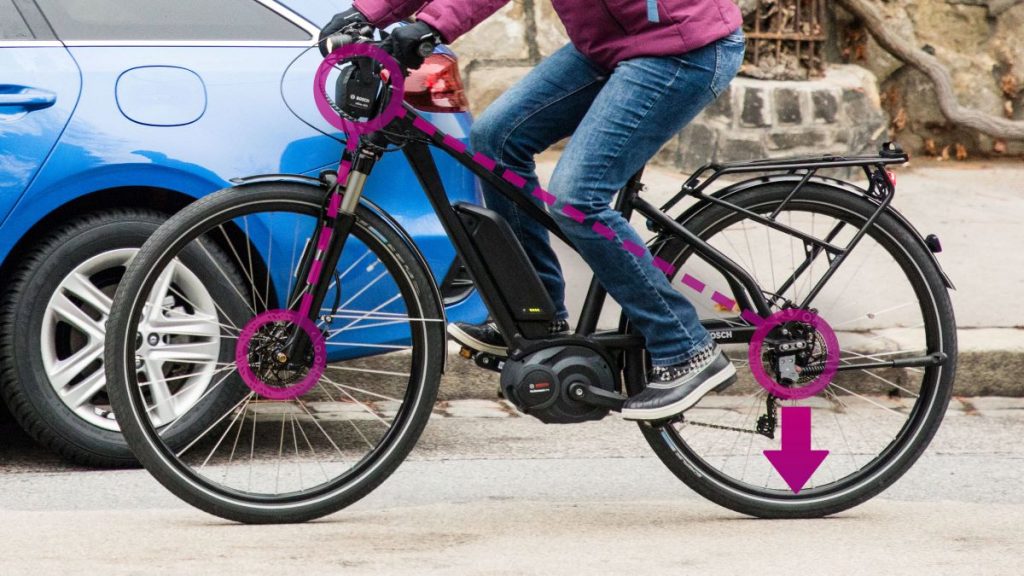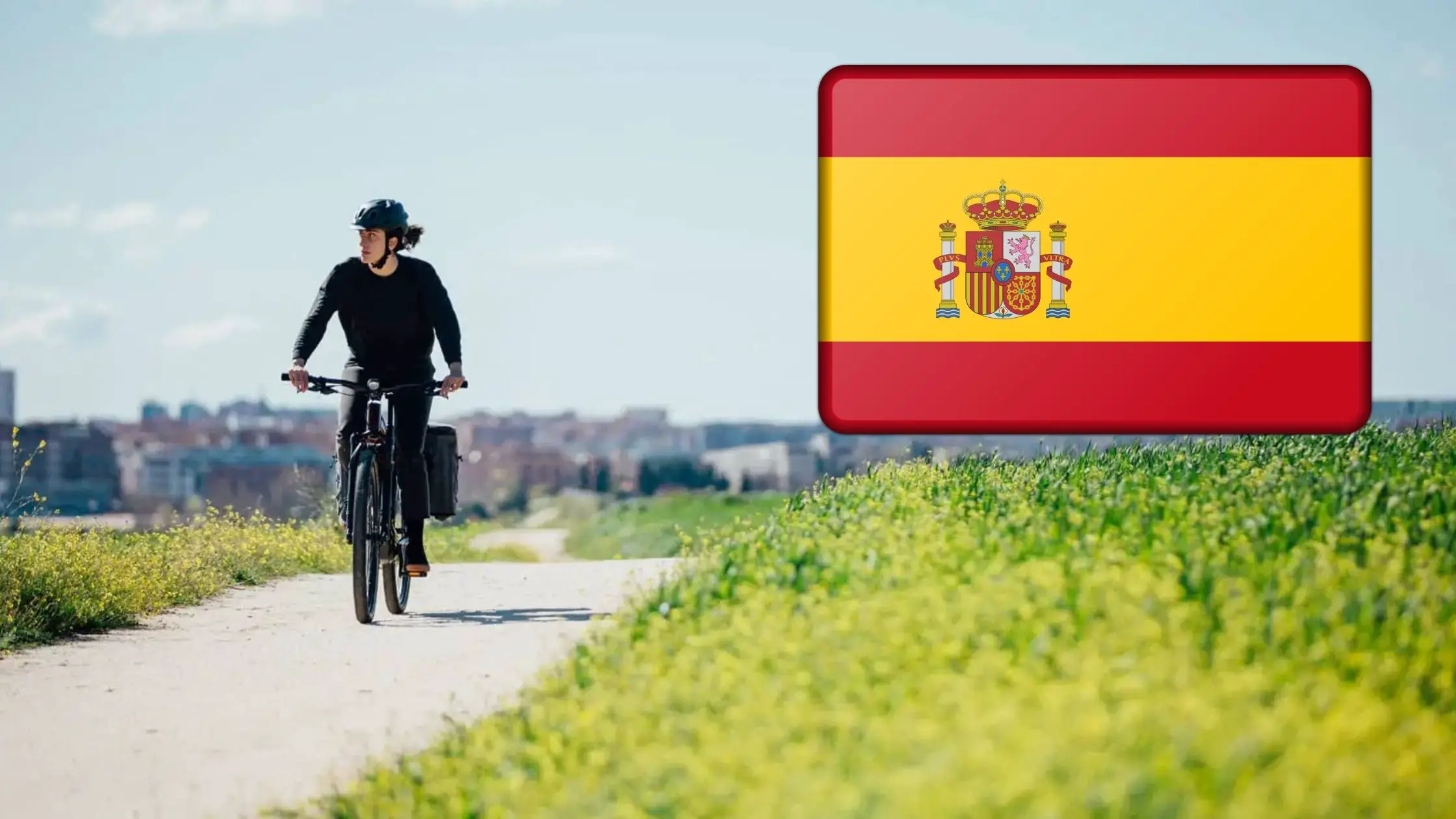Last Updated on June 29, 2023 by Igor Karni

Still not very popular on electric bikes, the ABS is an important ally to reinforce your safety during a critical braking phase. What is ABS? What does it do? How does it work, technically speaking? We’ll explain all the details in this article.
Table of Contents
Mandatory on motorcycles since 2017, this anti-lock braking system still has a long way to go to become a must-have on electric bikes. What is it made of? How does it affect braking? Are there different modes for different uses?
Bosch is leading this technology for e-bikes, and its elements are intrinsically linked to the core Bosch technology. However, Bosch is not alone on the market of ABS for electric bikes. The Italian manufacturer Blubrake has also made its entry.
The purpose of the various ABS systems on the market remains the same: to improve the safety of riders by improving the braking quality of e-bikes.
What is the purpose of ABS for electric bikes?
ABS is the acronym of the German term Antiblockiersystem, which means anti-blocking system. As you may have guessed, and as you may know, if you are a biker or a car driver, an ABS prevents a wheel from locking up during a critical braking phase. That is particularly useful in low grip conditions.
Read also: Can electric bikes get wet? And, Can I ride an e-bike in winter?
How does a bike or e-bike react in case of wheel lockup? If the rear wheel locks, the tire may chase if the ground is wet, for example. In this case, you can quickly lose control of your e-bike. On the other hand, if the front wheel locks, a “sun” can occur: the rear wheel takes off, and the rider goes over the handlebars. That is a fall.

Today, the braking systems installed on our two-wheelers can be powerful and biting, especially hydraulic disc brakes. In this case, applying the brake lever with force results in extremely intense braking, which can cause the wheel to lock. The rear brake is used more than the front brake to avoid the “sun” effect.
If the rear wheel locks, the rider can still control the e-bike. On the other hand, a front wheel lockup is usually more challenging to manage. In the case of Bosch, the ABS is installed on the front wheel. The idea: no matter how hard you brake, the wheel will not lock.
Read also: Are electric bikes dangerous? What are e-bike risks? And, How safe are electric bikes?
On paper, the promise is beautiful. In practice: it is kept. On wet ground, soggy leaves, slush, gravel, or grass, the system manages to regulate the front braking to provide a short stopping time and increased safety (1/3 of the accidents in e-bikes could be avoided if they were equipped with ABS, according to a Bosch study conducted in Germany). It even adds a fun dimension to the experience.
What is ABS for electric bikes made of?
In the case of Bosch, its latest generation system (2022) has been optimized: size reduced by 77% compared to the previous version for a weight saving of 55%. Then, the system is divided into several entities: a control unit fixed on the front fork and speed sensors on both wheels.
The whole system works together to provide the best possible coordination during an emergency braking phase. Finally, the screen on the handlebars plays a more passive role: it displays information about the bike’s behavior, such as the braking distance when ABS is activated.
How does ABS affect the front wheel?
The Bosch ABS relies on sensors that continuously calculate the speed of both wheels and the Bosch eBike ABS control unit, which is considered the system’s brain. The battery of the electric bike also powers this unit. If the battery runs dry, the safety elements – including the ABS – will continue to function for a short period (but not indefinitely).

The wheels’ sensors measure the wheels’ speed and the speed differential between the front and rear wheels. Thus, when it detects braking – in this case, the speed of rotation of the wheels decreases – a regulation system comes into play when a difference is detected. Thus, it automatically adapts the famous braking force.
If the sensor detects that the front wheel is turning slower than the rear wheel – in this case, it means that it is locking – then the ABS intervenes on the front brake hydraulic system: either it limits it, or it releases it, thus better regulating the hydraulic pressure of the said braking. And all this is done automatically. The pressure remains high enough to maintain a braking worthy of the name.
Specifically, the process involves repeatedly opening or closing a valve between the brake hose and the brake caliper. It is this valve that manages the hydraulic flow. It is also connected to the system’s electronic brain, the famous control unit that oversees the whole dance.
The valve regulates everything in a short time. So fast that there is no impression of jerking, and the reaction time between the moment when the valve is activated and the moment when the system is switched off is very short. For example, the reaction time from when the system detects the blockage to when the valve opens is 2 ms.
As a result, the front wheel does not lock up despite solid braking. The stability and maneuverability of the bike are thus guaranteed.
How many times per second does the system analyze the wheel speed?
It’s not a question of seconds but of frequency. The speed sensor on the front wheel is based on a disc placed parallel to the brake disc. A series of small holes at regular intervals has been made on this complimentary disc.

The sensor calculates the frequency at which these small holes run. The faster the wheels turn, the more regular the calculations because the more quickly the space between each small hole scrolls in the eyes of the sensor.
On the other hand, the system stops counting at low speeds: below 6 km/h, and no ABS regulation is performed, at least in the case of Bosch. The speed is considered too low.
What is the role of the rear wheel in ABS?
The rear wheel is not forgotten, even if it is not in the same position as the front wheel. So let’s be clear from the start: the Bosch ABS only regulates the braking of the front wheel. On the other hand, it can control the rear wheel’s take-off in exceptional situations.
For example, very powerful front braking on a high-grip surface can lead to the famous “sunshine” phenomenon described above. ABS can understand this physical phenomenon and slightly release the front brake pressure so that the cycle benefits from a small impulse and thus gets back on track.
One ABS, several modes, depending on the use
Because ABS can be managed electronically, several modes are available depending on the electric bike and its use. In total, four modes have been developed:
- ABS Touring: for electric city bikes;
- ABS Cargo: for electric cargo bikes;
- ABS Allroad: for electric all-terrain bikes;
- ABS Trail: for electric mountain bikes.
Each mode adopts different settings, except for the Touring and Cargo modes, which offer similar control. For example, this behavior emphasizes wheel stability during braking and rear wheel lift control.
With a longtail e-bike, transporting children is commonplace: it is, therefore, advisable to install an ABS mode adapted to this type of ride, which must mainly ensure the safety of the rear passengers. Especially since a cargo bike, due to its weight, develops a higher inertia: for Bosch, focusing on the stability of the front wheel was therefore essential.
Read also: How to select the best – mountain, touring, commuter, cruiser, junior, city here or here, trike, folding, hybrid, cargo, road, gravel, kids’s here or here e-bike – in our comprehensive e-bike selection guides.
On the other hand, an e-bike equipped with the Trail ABS mode will benefit from better reactivity at the brake lever, an increased speed reduction, and an optimal adaptation to the nature of the ground. Riders should be responsive and dynamic to perform more complex and sporty maneuvers.

At the same time, wheel stability and rear wheel lift control are more limited in the ABS Trail mode. Here, it is considered that the rider will rely more on his skills and body position to control these moves.
Finally, the Allroad ABS seems the most balanced of the four, with a slight emphasis on the rear wheel lift. An electric all-road bike can ride on city bike paths as well as on small roads and other medium-difficulty routes: it should be good in all areas.
Read also: Tips for using your e-bike on sand. Can I ride my e-bike in winter?
Concerning the Bosch ABS, each mode is chosen by the manufacturer according to the type of e-bike: it is, therefore, impossible to select the Trail mode on a city bike if it is not available as standard. On the other hand, the Allroad ABS and Trail modes can coexist very well depending on the cycle and its predefined abilities.
How is each mode designed to act differently?
Bosch has integrated specific parameters into the system for each mode offered to match the expected skills and abilities. Then, the set of installed sensors adjusts the behavior according to the pre-defined parameters. That does not mean that the braking quality will be better or worse with this or that mode: the purpose remains the same since the equipment is the same.
Still, for example, one mode will be able to activate the hydraulic flow control later, which will result in a slightly different behavior than another where the control is done earlier.
For the Trail mode, for example, used for electric mountain bikes, the idea is to provide good brake responsiveness and powerful braking to reduce speed. In this case, the famous valve will tend to close later to let the fluid press on the calipers and discs. In doing so, the ABS will activate a little later, but the braking will be powerful from the start.
Why ABS on the front wheel?
A legitimate question is: why develop an ABS for the front wheel, not the rear wheel? The answer is simple: the front brake is considered more efficient than the rear brake because it is generally more powerful. Also, the body’s and the bike’s weight are transferred to the front during a braking phase. In this case, the front tire is more loaded and can handle more brutal braking.
Read also: Front, mid-drive, or rear e-bike motor. Which one to choose? And, What are the differences between rotation and torque sensors?
This is one of the reasons why electric bicycle ABS is designed for one wheel and not the other. Installing such a system can push users to turn to the front brake more often, without fear, to extract the best braking performance.
In any case, it is strongly recommended to slow down with both brakes simultaneously, as they are designed to work in concert. Then modulate the pressure on the brake levers according to the situation’s urgency.
From motorcycle to electric bike
To design its first generation of ABS for electric bikes, Bosch used the smallest ABS module dedicated to motorcycles. Why? Because the technical effort was more straightforward and a change in brake design was enough to complete the project.

For this second generation of ABS, the German brand started from scratch to design a system that is 100% designed for e-bikes. The challenges for this system were as significant as those encountered on motorcycles or cars.
Bosch had to optimize the integration of the device but also reduce the weight: this is technically more complex and financially more expensive. Today, the ABS of the German company is compatible with only one model of Magura brakes.
Magura and Bosch, whose headquarters in Germany are located a few miles apart, actually shared a joint venture since 2019 under the entity Magura Bikes Parts. Bosch owns 50 percent of the shares.
In the future, other brands of brakes should be compatible with Bosch ABS, although the task is not necessarily easy: a series of significant changes must be made to the power of the caliper, the hydraulic flow, the volume of fluid, or the length of the lever.
Read also: Why are e-bikes so expensive? And, What is the difference between cheap and expensive e-bikes? And, Will e-bikes become cheaper?
It is also essential to know that an ABS is relatively expensive due to its design and added value: you have to count between 400 and 500 dollars or euros in the overall price of the e-bike, at least for the Bosch one. Therefore, such a system undoubtedly increases the final cost of an electric bike. In other words, not all the models on the market will have the right to it if you want to keep a reasonable entry-level offer.
On the other hand, we are only at the beginning of the ABS era for electrically assisted bikes. As the years go by, this system could enter a nice democratization phase with the arrival of new technologies and future price drops thanks to larger volumes. The future will tell us.
Igor is a sustainable mobility and green energy advocate. His mission for Easy E-biking is to help make electric cycling simple, practical, and fun. Follow him on Facebook and LinkedIn.




